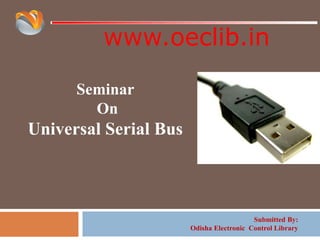
Universal Serial Bus (USB)
- 1. www.oeclib.in Submitted By: Odisha Electronic Control Library Seminar On Universal Serial Bus
- 2. Content History and Evolution Why We Need USB? Architectural Overview USB communication flow Protocol Layer Conclusion References
- 3. Key Word Down:From host to device Up:From device to host Example Down stream:data flow from host to device Up stream: data flow from device to host
- 4. History USB—Universal Serial Bus Invented and standardized by a group of computer and peripherals manufactures in 1995 Compete with IEEE1394
- 5. Evolution
- 6. Why We Need USB? Connection of the PC to the telephone: =>In order to transmit data Ease-of-use: =>Saupport plug and play Port expansion: =>Up to 127 devices =>Can add lots of device to a XX
- 7. Characteristic (2) The logical topology of the USB is a star structure It is similar to computer network The USB uses a polling protocol Up to 7 level
- 8. USB Can Do Combines low speed and high speed bus activity , USB enables shared access for both speed Automatic configuring of devices and a serial bus which is simplified and easy to plug into Attach / detach easily without restarting system
- 9. Architectural Overview Host:only one =>The smartest element in the USB system =>Responsible to the complexity of the protocol to make devices design simple and low cost =>Control the media access(no one can access the bus unless it get an approval required from the host )
- 10. USB System Member (2) Hub:one or more =>Like the hubs used for computer network =>Enables many devices to connect to a single USB port
- 11. USB System Member (3) Device:one or more =>Everything in the USB system , which is not a host , is a device ( include hubs) =>A device may provides one or more USB functions =>Has an unique address at the end of the enumeration process
- 14. Pipes (1) The logic communication between the client software on the host and the function on the device is done through pipes It is a association between a specific endpoint on the device and the appropriate software in the host
- 15. Pipes (2) An endpoint is the source or destination of the data that transmitted on the USB cable Two direction =>OUT: data flows from the host to the device =>IN: data flows from the device to the host
- 16. Signaling On The Bus The USB cable is 4 wire cable Signal on the bus is done by signaling over tow wires ( D+ and D_ ) =>1: D_ low , D+ high =>0: D_ high , D+ low Data encoding and decoding is done using NRZI ( Non Return to Zero Inverted )
- 17. SIE SIE:Serial Interface Engine It is part of both the host’s and the device’s physical layer =>Serialization and Deserialization =>Encoding and Decoding =>Generate(for out) and Verify(for in) CRC =>Detect PID
- 18. HC HC:Host Controller =>It is an additional hardware to ensure that everything which is transmitted on the bus is correct =>It serves both the USB and the host and has the same functionality in ever USB system
- 19. This Layer Handles Responsible for the translating the data between the application layer and the USB transactions protocol . Two Role =>USB System Software (in the USB host) =>USB Logical Device (in the USB device)
- 20. The USB System SW Compose of The Host Controller Driver and The USB Driver Responsible for =>Bandwidth allocation =>bus power management Two of above are in order to enable devices to access the bus
- 21. The USB Logical Device Compose of a collection of independent endpoints Each endpoint has an unique Endpoint Number and is unidirectional(except endpoint zero and has two type--In/Out) Default pipe is associated with endpoint zero
- 22. The Application Layer Host end:Client Software = >Manages the appropriate interface by transferring data from its buffers to the endpoint with the appropriate interface Device end:Function = >Composed of interfaces and controls the functionality of the device
- 23. Protocol Layer USB transactions are done through packets include three phases =>Token phase:host initiates token indicating the future transfer type =>Data phase:actual data transmitted =>Handshake phase:indicate the success or failure of the transaction
- 24. Transfer Types (1) Control Transfer =>Used to configure a device (enumeration) =>Compose of three phases (setup,data,status) Isochronous Transfer =>Used for multimedia devices =>It is guarantee the required bandwidth =>No handshake phase
- 25. Transfer Types (2) Bulk Transfer =>Used for large burst data =>Guarantee of delivery , no guarantee of bandwidth or minimum latency Interrupt Transfer =>If there is a pending interrupt , the function will send details to host after host poll it
- 26. Packet (1) PID:Packet Identifier Field Address Field =>So , there are up to 127 devices in USB
- 27. Packet (2) Token Packet =>ADDR & ENDP define an unique endpoint
- 28. Packet (3) Data Packet
- 29. Packet (4) Handshake Packet =>Such as ACK 、NAK 、STALL…etc.
- 30. Conclusion USB is powerful and easy to use The complex host make the device easy to design